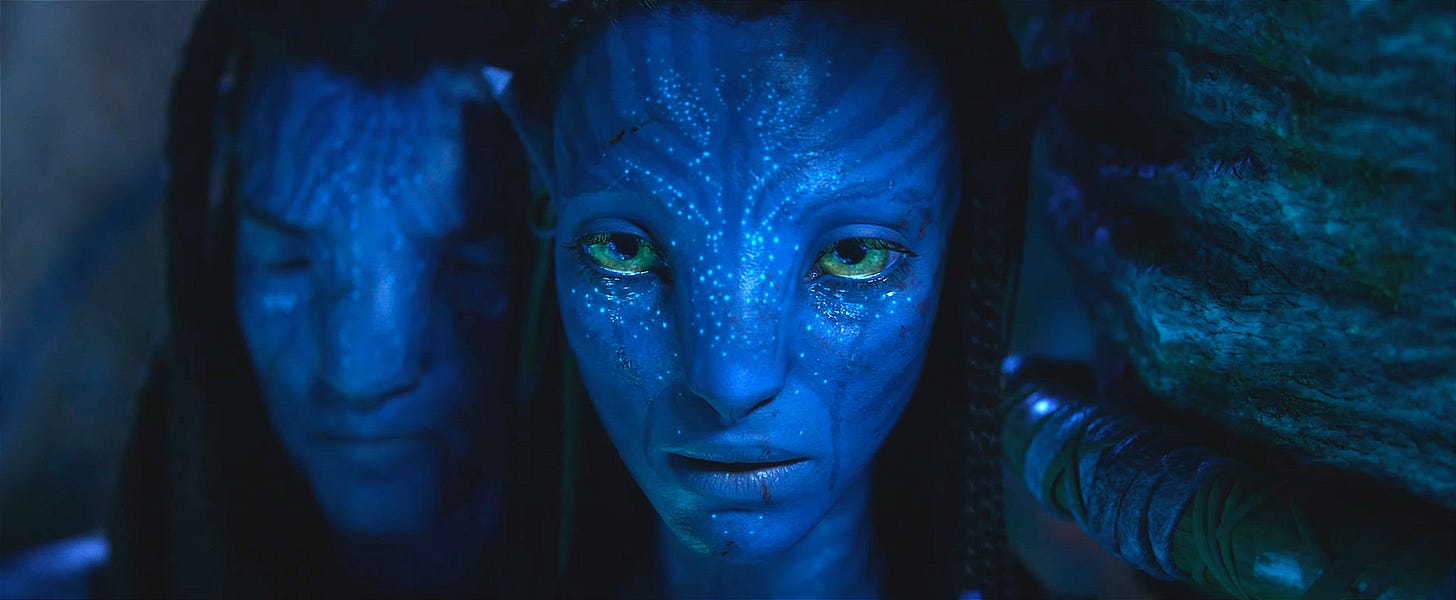"Avatar: Fire and Ash" Official Trailer: Can James Cameron’s Record-Breaking Franchise Finally Break Into the Cultural Zeitgeist Like Never Before?
Despite record-breaking box office returns, Cameron’s franchise still struggles to find cultural traction—will this third film finally change that?
Oscar-winning filmmaker James Cameron will no doubt go down in the history books as one of our greatest cinematic visionaries. There’s no doubt that films like The Terminator, T2, True Lies, and Titanic will go on to have a lasting legacy, influencing generations of filmmakers and continuing to thrill audiences for decades to come.
Like many film pioneers that came before him (Lucas, Coppola, Spielberg, Kubrick, etc.), Cameron has already planted his flag in the annals of film history, reshaping what audiences expect from blockbuster cinema and pushing the boundaries of technology and storytelling with each ambitious project.
Now at age 70, Cameron seems to be capping off his film career with the Avatar franchise, a groundbreaking sci-fi epic that not only showcased his mastery of visual effects but also introduced an entirely new cinematic world that captivated global audiences. With a third installment coming this year and a fourth one slated for 2029, Cameron has at the very least booked up his schedule for the next four years... perhaps even longer if he decides to continue expanding the world of Pandora with future projects.
That being said, Avatar also lives in this rare space—one that undeniably results in phenomenal global box office returns but is rarely spoken about in the film geek community. There’s a constant debate about the virility of this franchise. Does Avatar have the cultural cachet to match its box office dominance? Or is it simply a spectacle-driven event that dazzles in the moment but fades quickly from the larger cultural conversation?
Obviously, the message of Avatar is a universal one: the struggle and fight of an Indigenous population against the corporate machine. It’s a familiar David-versus-Goliath narrative, one that taps into themes of colonialism, environmental destruction, and spiritual connection to land. These are all important issues that Cameron has talked about and seems to be deeply concerned with on a personal level.
Cameron, being a self-described sci-fi nerd, would know that some of the great science-fiction works also dealt with these very themes—whether it’s the ecological warnings of Silent Running, the anti-imperialist tones of Dune, or the rebellious spirit embedded in The Matrix.
And of course, the original Star Wars film was the very movie that inspired Cameron to pick up a film camera and give cinema a try. Star Wars itself was George Lucas’s attempt to tap into the themes of colonialism and foreign occupation, serving as a clear metaphor for the Vietnam War—a political commentary on the overreach of the U.S. military-industrial complex, where dehumanizing tactics are used to conquer defenseless countries.
The Death Star symbolizes the bombings of Vietnam, Laos, and Cambodia—or perhaps even the unresolved, lingering debate over the atomic bombings of Hiroshima and Nagasaki in WWII. A show of overwhelming power, but at the cost of countless innocent lives.
Now count us as those who feel pretty ambivalent about Cameron’s Avatar franchise. They are, without a doubt, visual spectacles—with the first film being a great example of how to use 3D technology correctly and effectively. But sadly, 3D has become more of a theater gimmick than a game-changer, with few films since managing to use it with the same level of craftsmanship or purpose. The novelty has simply worn off.
What’s left is this story of a family of Na’vi warriors and human allies brought together in the battle for Pandora, fighting against a military-driven campaign to drive the Indigenous population off their land in order to satisfy a powerful corporate entity bent on extracting all of Pandora’s natural resources.
Now back in 2009, when the first Avatar film came out, that concept wasn’t as relevant as it is now. And while we’ll be among the first naysayers to argue that the Avatar films aren’t living up to their full potential—and let’s be honest, the computer effects still have this uncanny valley thing that’s hard to look past—we also can’t deny that Cameron is at least aiming for something meaningful, something that resonates more deeply than your average blockbuster.
Avatar just might be worth a revisit and reexamination, especially as real-world events begin to mirror the film’s environmental and political warnings more than ever before.
And it will be interesting to see if Avatar: Fire and Ash, the third installment in the franchise, can break box office records again when it lands in theaters at the end of the year.
But perhaps this time, it will finally achieve the kind of cultural cachet that has largely eluded the series so far. With the film’s themes of occupation, resistance, and displacement—and the growing parallels to real-world conflicts like Gaza—we can imagine those ideas will be lingering in people’s minds as they watch on the big screen in December.
Official Synopsis:
With “Avatar: Fire and Ash,” James Cameron takes audiences back to Pandora in an immersive new adventure with Marine turned Na’vi leader Jake Sully (Sam Worthington), Na’vi warrior Neytiri (Zoe Saldaña), and the Sully family.
The film, which has a screenplay by James Cameron & Rick Jaffa & Amanda Silver, and a story by James Cameron & Rick Jaffa & Amanda Silver & Josh Friedman & Shane Salerno, also stars Sigourney Weaver, Stephen Lang, Oona Chaplin, Cliff Curtis, Britain Dalton, Trinity Bliss, Jack Champion, Bailey Bass and Kate Winslet.
Experience the film only in theaters December 19.






